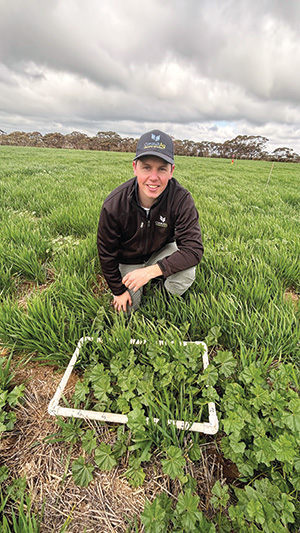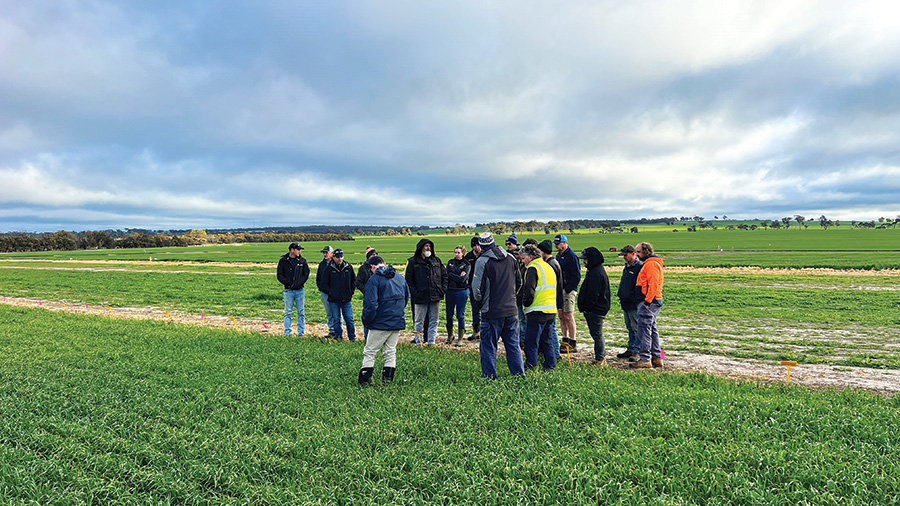Control of marshmallow in crops and pastures, and grassweeds in oats, in particular, are receiving attention through two GRDC National Grower Network supported projects.
Control measures for marshmallow
A review to update control measures for marshmallow in southern Western Australia is underway in response to changing cropping regimes that have allowed the weed to flourish in direct competition with crops during the growing season.
 ConsultAg’s Gray Yates at the Varley marshmallow trial. Photo: Justine Tyson, ConsultAg
ConsultAg’s Gray Yates at the Varley marshmallow trial. Photo: Justine Tyson, ConsultAg
Growers report that marshmallow’s late summer and early autumn germination pose the greatest management challenges, particularly since the adoption of no-till and the decline in livestock integration.
Inadequate control of these early germinations during the fallow period leads to the presence of large, uncontrollable plants at sowing. These are difficult to eradicate during the growing season, competing with crops, potentially contaminating grain at harvest and serving as hosts for insects. Their large canopies can prevent pre-emergent herbicides from reaching the soil, hindering the control of subsequent germinations.
GRDC’s National Grower Network (NGN) enables research to be focused on localised issues challenging cropping systems. This project is a two-year investment to review and update control measures for marshmallow in three locations: Narrogin, Kulin and Newdegate.
Trent Butcher from ConsultAg, who is managing the investment, says there is a gap in the understanding of growers in the biology and ecology of marshmallow and this determines the success of management decisions.
“In particular, information on best practice techniques to manage late summer/early autumn germinations of marshmallow is lacking, together with how to identify and manage escapees prior to sowing the crop itself,” he says.
The trials have identified best practice techniques for continuous cropping systems and rotations that include a legume pasture.
Three trial sites were established looking at different marshmallow control methods in a variety of crop, pasture and knockdown settings:
- The Narrogin site investigated the level of brownout control from a range of herbicides in a knockdown scenario over 49 days, with an emphasis on Group 14 chemistry.
- The Kulin site focused on in-crop control of surviving marshmallow using registered in-crop herbicides.
- The Newdegate site investigated the control of marshmallow in a medic pasture. Marshmallow populations often set seed in this context, causing issues in the subsequent cropping phase. The sensitivity of medic to herbicides has meant that control options are expensive or difficult to employ.
Early rainfall across all three sites varied in the 2023 season. There was little summer rain, with the break of season arriving in late March, resulting in reduced summer marshmallow germination. Adequate rainfall was observed from March to September at all sites, except Newdegate, which saw only 6.8 millimetres in May.
Mr Butcher says the marshmallow targeted were autumn germinations, with smaller weeds compared with those germinating in late summer. “All sites had dense weed populations, but the actual plant size was small, likely increasing treatment efficacy.”
Results
Mr Butcher says that the three trials delivered sound conclusions and recommendations that growers would be able to draw from and implement into their systems.
The Narrogin trial, focused on marshmallow control in a knockdown scenario, found that adding Group 14 spikes increased the speed of control.
New generation Group 14 herbicides Terrad’or® (tiafenacil), Sharpen® (saflufenacil) and Voraxor® (saflufenacil and trifludimoxazin) provided superior speed of brownout, he says, when compared to older Group 14 products – Hammer® (carfentrazone-ethyl) and Goal® (oxyfluorfen). For this trial, all Group 14 mixtures, except for the treatment including 2,4-D Ester, achieved high levels of control 22 days after application. Further studies aim to confirm this.
At the Kulin site, the in-crop control was assessed by evaluating the percentage of brownout and recovery after application. In the absence of crop competition, one litre per hectare of Quadrant® (diflufenican, bromoxynil, MCPA and picolinafen) offered the highest level of control.
“Treatments containing Hammer® resulted in very fast brownout but plants soon recovered.”
While no treatment provided total control of marshmallow 28 days after treatment, it is believed that the addition of pre-emergent herbicides and crop competition would improve product performance.
The Newdegate trial site highlighted the limited herbicide options in medic. “Results from this herbicide screening showed that many options do not provide sufficient control of marshmallow,” Mr Butcher says. However, high levels of control were achieved with Group 2 chemistries Raptor® (imazamox) and Broadstrike® (flumetsulam) with limited impact on the medic pasture.
“Careful consideration is needed when using these Group 2 chemistries in rotations,” Mr Butcher says.
Selecting a product for marshmallow control pre-seeding or in-crop must consider the risk of resistance developing, which could hinder long-term control.
He emphasises that weed eradication by preventing seed-set in problem paddocks should be the objective. “This might involve targeted earlier spray-topping in the pasture phase, though further research is needed into effective products and timing of applications.”
Findings from the 2023 work are being extended through NGN meetings while more in-depth work on marshmallow management in cropping systems is being investigated this season.

The ConsultAg team and growers assess weed control in oats. The trials, at Narrogin, were showcased as part of 2024 OATSPO. Photo: ConsultAg
Grass weed management in oats
Using herbicides on oats is challenging because the crop is more susceptible to damage and there are limited pre-emergent options, reducing the effectiveness of available weed control products.
Additionally, the smaller market for oats, compared with wheat and barley, further constrains the development and registration of herbicides.
Alternative weed control methods such as crop competition could be considered for oats. However, although oats are considered competitive with weeds, there are limited studies quantifying their impact on weed populations, which challenges assumptions about their weed competition efficacy.
Integrating weed management (IWM) strategies for oats are also a possibility, but there is a lack of regionally specific validation and information on chemical, non-chemical or cultural grass weed management strategies specific for oats in Australian conditions.
The incorporation of IWM strategies will be essential for a crop that has limited herbicide options to improve the prospects of suppressing and controlling problematic weeds such as wild oats, annual ryegrass and brome grass.
To address these issues, GRDC has invested with ConsultAg through its National Grower Network in a two-year study aiming to provide improved strategies for the effective management of problematic grass weed species in oat grain crops.
Trent Butcher, from ConsultAg, says that his team has established several trials to showcase and expand growers’ options for refined agronomic strategies to effectively manage the problematic annual grass weed species – annual ryegrass, brome grass and wild oat in oat crops.
“Trials will focus on a combination of chemical and agronomic practices to control annual ryegrass and brome, and also investigate non-chemical weed suppression methods,” Mr Butcher says.
Seeding rates and depths of oats will be investigated together with herbicide applications.
The unique long coleoptile and mesocotyl of oats allow deeper sowing into subsoil moisture. With good management, this can be exploited to germinate oats before the weeds to improve the competitive ability of oats over the later-germinating grass weeds.
As oats are sensitive to various herbicides, it is important to maintain good separation between the seed and applied herbicides.
“We will also apply banded nutrition under the seed to see if this provides a competitive boost for oats.” The trials provide the opportunity to explore new herbicide options to find out if they are safe and effective for potential future registration in oats.
More information: Trent Butcher, tb@consultag.com.au

























































